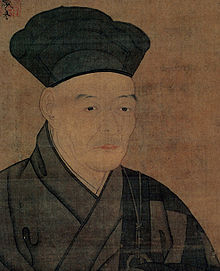Sesshū Tōyō
Sesshū Tōyō (雪舟 等楊, c. 1420 – August 26, 1506), also called Sesshū (雪舟), was a Japanese Zen monk and painter. He is thought to be a master of Japanese ink painting. He was inspired by Chinese landscapes. His work has a Japanese style that shows Zen and Buddhism.[1] His famous work was of landscapes, portraits, birds, and flower paintings. These works all had Zen Buddhist beliefs, and a flattened perspective.[2]
Sesshū | |
|---|---|
 A 16th century copy of Sesshū's 1491 self-portrait | |
| Title |
|
| Personal | |
| Born | c. 1420 |
| Died | 26 August 1506 (aged 85–86) |
| Religion | Buddhism |
| School | Rinzai |
| Senior posting | |
| Teacher | Tenshō Shūbun |
Sesshū was born into the samurai Oda family (小田家) and trained at Shōkoku-ji temple in Kyoto as a Zen monk.[1] From his childhood, Sesshū showed talent for painting. He eventually became known throughout Japan as a wise Zen scholar. He was soon called the greatest painter priest of Zen-Shu.[3]
Sesshū trained under Tenshō Shūbun (c. 1418–1463). After Sesshū visited China, he was inspired to include it in his own work. His paintings began to have a unique Chinese and Japanese style..[3] Sesshū's influence on painting was so large that many schools of art made him their founder.[4] Sesshū's most famous works are Winter Landscape (c. 1470s), Birds and Flowers (1420–1506) and Four Landscape Scrolls of the Seasons (1420–1506).
Paintings and techniques
changeSesshū's works are mostly suibokuga, or "water and ink paintings".[1] Zen Buddhism focuses on simplicity and the natural world. To perform this, Suibokuga artists use only black ink.[1] Sesshū used black sumi, or charcoal or soot-based solid ink on paper or silk.[5] Sesshū's most famous works include Winter Landscape (c. 1470s), Four Landscape Scrolls of the Seasons (c. 1420 – 1506) and, Birds and Flowers (c. 1420 – 1506). These all show his use techniques to show zen beliefs.[2]
Famous works
changeLandscapes
change- Four Landscape Scrolls of the Seasons (c. 1420–1506)
- Winter Landscapes from Landscapes of the Four Seasons (c. 1420–1506); Tokyo National Museum)
- Autumn and Winter Landscapes (c. 1470s; Tokyo National Museum)
- Short Scroll of Landscapes (c. 1474–1490; Kyoto National Museum)
- Long Scroll of Landscapes (Sansui Chokan) (c. 1486; Mori Collection, Yamaguchi, Japan)
- Haboku Sansui, "splashed-ink" technique scroll (1495; Tokyo National Museum)
- View of Ama-no-Hashidate (c. 1502–1505; Kyoto National Museum)
- Landscape by Sesshū
Other
change- Portrait of Masuda Kanetaka (1479; Masuda Collection, Tokyo)
- Huike Offering His Arm to Bodhidharma (Daruma and Hui K'o) (1496; Sainen-ji, Aichi, Japan)
- Flowers and Birds, pair of sixfold screens (undated; Kosaka Collection, Tokyo)
Related pages
changeReferences
change- ↑ 1.0 1.1 1.2 1.3 Stokstad, Marilyn; Cothren, Michael (2017). Revel Art History. Vol. 2 (6 ed.). Pearson. ISBN 978-0134481012.
- ↑ 2.0 2.1 Fowler, Michael D. (17 March 2017). "Spatial confluences between the ink paintings and garden designs of Sesshū Tōyō". Studies in the History of Gardens & Designed Landscapes: 144–157.
- ↑ 3.0 3.1 Miyamoto, Kiyoshi. "sesshu toyo". Masuda City Tourist Information Center.
- ↑ Ford, Dorothy (2010). "The Greatest Perfection: Spatial Aberrations in Sesshu's Long Scroll". Undergraduate Library Research Awards.
- ↑ Mittman, Dr Asa Simon (3 August 2019). "Nature: spotlight — Sesshu Toyo's Winter Landscape". Smarthistory.